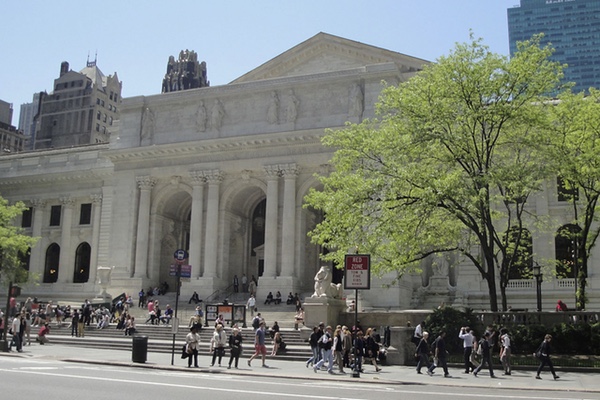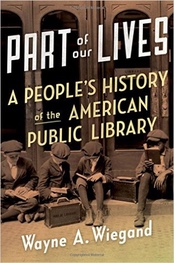The Secret Life of the Public Library

Scholars and public intellectuals have always been friends of libraries, but too often their personal experiences skew perceptions of what libraries have done for their communities over the generations. In a recent New York Times op-ed, Alberto Manguel declared: “Today, the principal danger facing libraries comes not from threats” like fire, war, and water, “but from ill-considered changes that may cause libraries to lose their defining triple role: as preservers of the memory of our society, as providers of the accounts of our experience and the tools to navigate them—and as symbols of our identity.” He is especially worried about “preserving the centrality of the book” in librarianship.
 I
certainly have no quarrel with the library’s obligation to
perpetuate these roles, but Manguel’s perspective is too narrow.
Take the American public library, for example. As important as
public libraries are to preserving the centrality of the book, they
have been equally—sometimes more—important as public places.
From their beginnings in the mid-19th century they have
served homeless people, often providing a solution to a problem other
civic institutions ignored or overlooked. In the early 20th
century, as over 1,600 Carnegie buildings went up across the country,
their ubiquitous “community rooms” hosted hundreds of thousands
of community activities, including local health fairs and Sunday
musicals—sometimes with local talent, sometimes with recordings on
newly acquired Victrolas.
I
certainly have no quarrel with the library’s obligation to
perpetuate these roles, but Manguel’s perspective is too narrow.
Take the American public library, for example. As important as
public libraries are to preserving the centrality of the book, they
have been equally—sometimes more—important as public places.
From their beginnings in the mid-19th century they have
served homeless people, often providing a solution to a problem other
civic institutions ignored or overlooked. In the early 20th
century, as over 1,600 Carnegie buildings went up across the country,
their ubiquitous “community rooms” hosted hundreds of thousands
of community activities, including local health fairs and Sunday
musicals—sometimes with local talent, sometimes with recordings on
newly acquired Victrolas.
Although not trained as social workers, caregivers, babysitters, or medical advisors, librarians stepped in and did the best they could when needed, functioning in humane ways rather than serving “the idiocies of bureaucracies” Manguel laments. One of my favorite stories: At the New York Public Library’s 96th Street Branch in 1961 a patron asked a librarian, “I want to know how to take an enema.” Because he was not satisfied with his pharmacist’s instructions, “he plied me with detailed questions,” the librarian reported, “until there was nothing left to ask,” then left.
As places public libraries have always hosted activities that contributed to the public culture. To cite but a few examples from the last two decades of the 20th century, at the Bloomington (IL) Public Library Planned Parenthood hosted a “town meeting” on abortion rights in 1992. Two years later an infertility support group organized there. In the Bronx’s Melrose Branch that same year the New York Black Women’s Health Project sponsored a series of workshops, including “Love, Intimacy, and Sexual Health” (for HIV/AIDS prevention), “Sweet Sensations” (for safe sex and healthy relationships), and “Stress Prevention.” In 1991 the Richmond (VA) Public Library hosted a program on “Women and Human Rights Abuse” cosponsored by Amnesty International and the YWCA Women’s Advocacy Program.
Angry at the treatment the U.S. Senate accorded Anita Hill during confirmation hearings for Supreme Court Justice Clarence Thomas, local women organized a National Organization of Women chapter at the Hingham (MA) Public Library in 1991 “to raise awareness of women … and give them a place to go and talk about problems they are encountering in society and the workplace.” Unity, a nonprofit group for battered women and their children, met in Baltimore County public libraries in 1992; across the country other Unity chapters did likewise. In 1999 the Orlando (FL) Public Library hosted “Portraits of Courage,” an exhibit documenting stories of local breast cancer survivors.
In 1983 a Mothers Against Drunk Driving (MADD) chapter met at the Santa Ana (CA) Public Library. In 1992 puppeteers circulated Brooklyn’s public libraries to teach children about the disabled. “I learned not to make fun of people who are disabled,” said one ten-year old. In 1993 the Omaha Public Library hosted baby-sitting clinics for children eleven and older.
In 1990, the Downey City (CA) Public Library was among scores across the country hosting a Talking About Vietnam” series. “Public libraries are the best institutions in which to discuss the war and its ramifications,” the Los Angeles Times reported. In 1991 the Minneapolis Public Library hosted programs on everyday life in World War II. The first was “Nisei Women Remember: The Story of Japanese-American Evacuation and Internment.” In 1999 the Salt Lake City Public Library was one of twenty hosting an exhibit, “A More Perfect Union: Japanese Americans and the United States Constitution.” For six weeks patrons viewed photographs, documents, and a video showing the World War II experiences of 120,000 Japanese Americans who lost their property and were imprisoned in “relocation camps.” A year later the Seattle Public Library scheduled “Relocation from the Camps: A Panel Discussion.” Panelists included a federal official who relocated Japanese Americans, as well as several camp internees.
As long as scholars and public intellectuals like Manguel and the millions of people who frequent public libraries across the globe insist on the centrality of the book, it will happen. Equally as important for millions of others, however, is the role of library as place. For the past century-and-a-half American public libraries have been public places of performance where users displayed moral progress and achievement. They have also operated as a robust commons where members of the public discussed a variety of issues that concerned them. They have functioned as centripetal forces to craft a sense of community among disparate populations and evolve community trust between its multicultural elements. They have acted as key players in constructing group identity through the books and places they provided. And they have started neighborhood conversations, welcomed the recently arrived into their midst, and served as community anchors.
These are not “reinventions,” but historically overlooked traditions of American public library service every bit as central to their users’ needs as the book.